Apple's 2010 MacBook Air (11 & 13 inch) Thoroughly Reviewed
by Anand Lal Shimpi on October 26, 2010 10:08 PM EST- Posted in
- Mac
- Apple
- MacBook Air
- Laptops
The SSD: Not Half Bad
Apple advertises the new MacBook Air as being instant on as a result of the internal SSD. That’s mostly untrue. From a completely powered off state the MacBook Air still takes time to boot. That time is significantly reduced compared to the old MacBook Air and any other Mac with a conventional hard drive. It’s even a shorter boot than my MacBook Pro with a SandForce SF-1200 based SSD in it:
| System Performance Comparison | ||||||
| Boot | Shut Down | Sleep | Awake | |||
| 11-inch MacBook Air | 15.5 seconds | 2.2 seconds | 1.0 second | 1.63 seconds | ||
| 13-inch MacBook Air | 14.4 seconds | 1.9 seconds | 1.0 second | 1.56 seconds | ||
| 13-inch MacBook Air (Late 2008) | 34.4 seconds | 2.9 seconds | 1.6 seconds | 4.19 seconds | ||
| 15-inch MacBook Pro (SF-1200 SSD) | 19.1 seconds | 1.8 seconds | 1.5 seconds | 2.3 seconds | ||
| 15-inch MacBook Pro (Mid 2009, HDD) | 34.2 seconds | 2.8 seconds | 1.8 seconds | 2.1 seconds | ||
You'll notice that even the SF-1200 SSD in my 15-inch MacBook Pro takes longer to boot than these new Airs. Apple does customize the firmware on its SSDs. I’d be willing to bet the SSD in the MacBook Air has tight integration with OS X to guarantee quicker than normal boot times.
Clearly the new Air isn't instant on from a boot standpoint, but it's pretty much there from a recover-from-sleep standpoint. The new Airs both go to sleep and wake up from sleep quicker than any of the other Macs, including my upgraded 15-inch Core i7 MacBook Pro. Again, nothing can trump Apple's tight integration between hardware and software.
Apple likes to work with two different controller manufacturers for SSDs: Samsung and Toshiba. iFixit already confirmed Toshiba is in the new MacBook Air with its teardown:
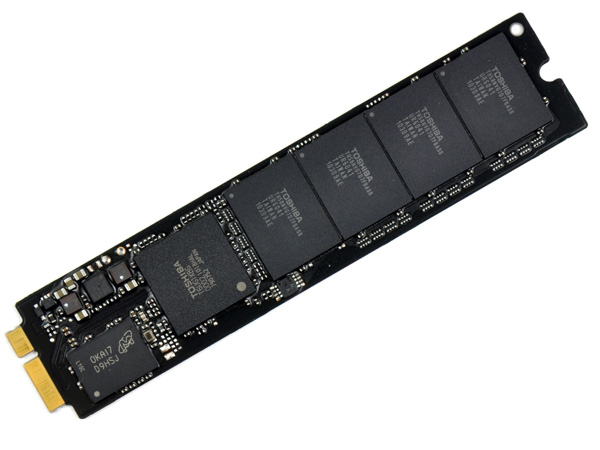
The 11-inch MacBook Air SSD, courtesy of iFixit
The SSD isn’t in an industry standard form factor, although the connector appears to be either micro or mini SATA. Presumably 3rd party SSD manufacturers (ahem, SandForce partners I’m looking at you) could produce drop in replacements for the MacBook Air SSD.
There’s nothing particularly innovative about the form factor of the SSD, other than Apple did away with the unnecessary space a 2.5” SSD would require. Just as SSDs will break the traditional SATA interface barriers, we’ll see the same happen to form factors as well.
The part number on the Toshiba controller may look familiar to some of you. It’s the same controller that’s in Kingston’s SSDNow V+ Series and the SSDNow V Series Boot Drive. I reviewed the latter not too long ago and found that it was a good drive for the money, and here’s the kicker: the SSDNow V Series Boot Drive was amazingly resilient when written to without TRIM support. Its performance hardly dropped as a result of normal desktop use. This is very important because although OS X 10.6.4 has a field for reporting TRIM support on an SSD, the instruction isn’t actually supported by the OS. Even the new MacBook Airs don’t ship with a version of OS X with TRIM support.
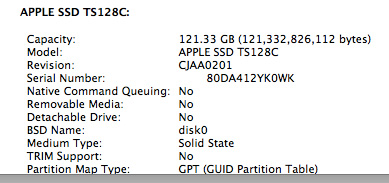
The SSD only has four NAND devices on it. Typically that would mean some very low transfer speeds, particularly on writes. But each one of those four devices has at least 16GB of NAND, spread across multiple planes and die. With the right firmware, you should be able to extract a good deal of parallelism from this architecture. Apple and Toshiba apparently do just that.

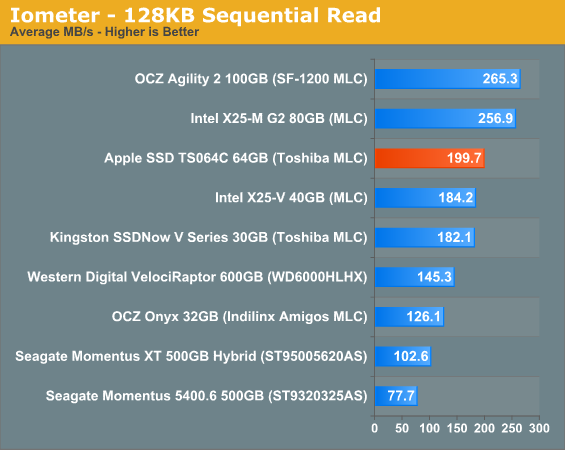
While most value SSDs top out at under 100MB/s, we get nearly 200MB/s sequential reads and writes out of the SSD in the new MacBook Air. And fortunately, Apple hasn’t only focused on sequential performance. The random read/write performance of the new MacBook Air SSD isn’t terrible:
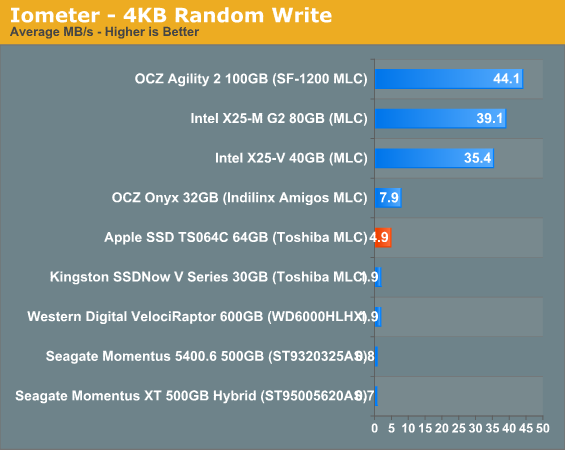
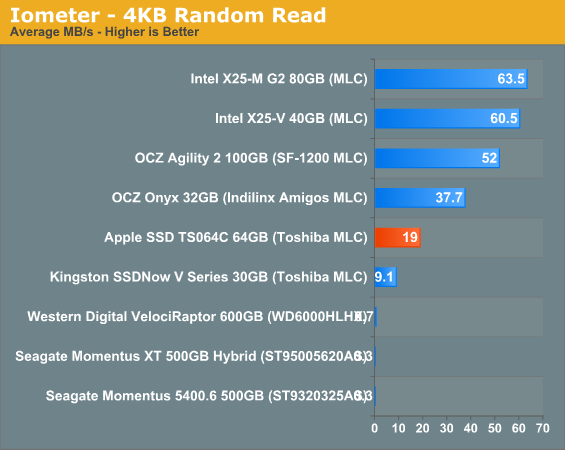
Random write performance is of course the weak point, but you’ll notice that it’s actually higher than the Kingston drive that uses the same controller. While Apple would’ve been better off striking a deal with Intel or SandForce for the controller in the MacBook Air, the Toshiba controller isn’t horrible.
As I mentioned earlier, resilience is very important as OS X still doesn’t support TRIM. I filled the drive with garbage and then tortured it for 20 minutes with random writes. The resulting performance drop was noticeable, but not unbearable:
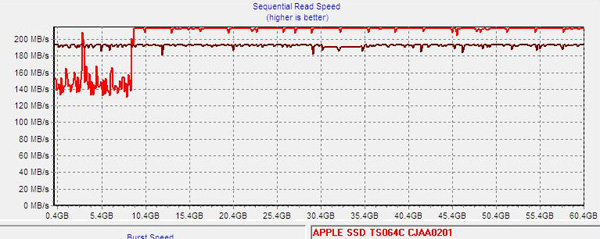
A single pass of sequential writes restores performance to normal:
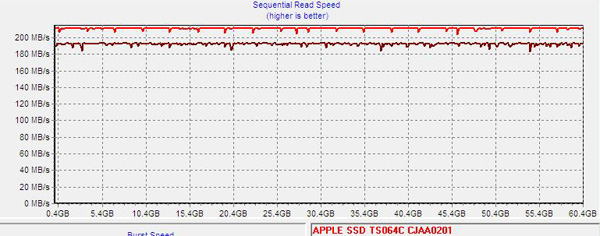
This tells us two things. First, through normal use the drive should be able to recover its performance over time (assuming you give it enough spare area). And second, if there’s any idle garbage collection in Apple’s custom firmware for the Toshiba controller it should be able to keep the drive running at peak performance even without TRIM supported in the OS. I don’t have a good way of measuring whether or not there’s GC enabled on the drive in OS X, but I suspect Apple is (at least it appears to be doing so on the Mac Pro’s SSDs).
Overall I’m pleased with Apple’s SSD selection. It could’ve been a lot better but it could’ve been a lot worse. The MacBook Airs in their default configuration have better IO performance than any other standard config Mac sold on the market today, including the Mac Pro.










185 Comments
View All Comments
bigboxes - Wednesday, October 27, 2010 - link
Get it through your thick skull, an Apple is not a Ferrari. It's just another pc. An overpriced pc. As soon as you come to that realization you'll sleep better at night and save your $$.MeesterNid - Wednesday, October 27, 2010 - link
Errr...it sure seems like your skull is much thicker there buddy as he just gave you solid, logical reasoning and all you did was post incoherent blabbering about how Apple is not a Ferrari. You should try searching Google for the meaning of a "metaphor" there.But alas, I fear logic and reason do not fit into your "reality" filtered through, what's probably baseless, anti-Apple bias.
Good day.
bigboxes - Wednesday, October 27, 2010 - link
I know what a metaphor is. Do you really think I thought that an Apple PC is a car with four wheels that you can transport you from point A to point B using an internal combustion engine? Really?So, since you need clarifying... *sing along with me*... an Apple Computer is just another PC... an overpriced PC. A pretty PC with no cutting edge technology, but still more expensive nonetheless. No anti-Apple bias on my part because I point out the obvious. And no, Apple is not a BMW either (another metaphor in case you think I am mistaking a PC for an automobile).
synaesthetic - Wednesday, October 27, 2010 - link
Apple is more like a Lexus.A more expensive and shinier rebranded Toyota--err, PC.
=)
JVC8bal - Wednesday, October 27, 2010 - link
A Lexus is nothing like a base Toyota. They use separate unibodies, engines, etc. and only share little things like cabling and mirrors - as do all car brands and their platform strategies. Let's not forget the extra engineering that goes into quality or a quiet ride.You obviously have not owned a Lexus or are intimately familiar with - and judging from your witt, never will.
michael2k - Wednesday, October 27, 2010 - link
A Mac is nothing like a base PC. They use separate cases, batteries, motherboards, etc. and share only little things like connectors and ports - as do all PC brands and their platform strategies. Let's not forget the extra engineering that goes into quality or superior battery life.You obviously have not owned a Mac or are intimately familiar with - and judging from your wit, never will.
UltimateTruth - Monday, November 1, 2010 - link
"A Lexus is nothing like a base Toyota. They use separate unibodies, engines, etc. and only share little things like cabling and mirrors "I'm sure he's not talking about base Toyotas. And yes, models do share MANY common components from little things like hose clamps, electrical connectors up to engines and transmissions in their platforms.
The DI V8 in the bloated 350 IF-S is the same as used in the home market Toyota Crown. Variants are used in Tundras and Sequoias.
Toyota and it's subsidiaries makes the components. Lexus is just an upscale brand of Toyota Motor Co..
MeesterNid - Wednesday, October 27, 2010 - link
Brother, your ability to carry on a coherent, rational debate with adults needs practice. Allow me to illustrate:1. While my assertion that you do not understand the meaning of the word metaphor was clearly sarcastic you proceed to define it in your response making it look like you either really didn't know what it meant or felt insecure enough to have to prove your knowledge.
2. You, once again, spout unsubstantiated nonsense about Apple being "just another PC" while in fact Apple does a good bit of original design in their products unlike other PC OEMs (i.e. you should put forward, or at least attempt to, some reasoning that lead you to your conclusion).
3. Your statement that Apple is not a BMW is redundant to your previous one of it not being a Ferrari, but beyond that you bring that comparison up for no reason. That just makes your previously illogical ranting sound childish.
I'm not even going to attempt to debate your statement about your not being biased "because [you] point out the obvious" as I'm afraid reason may be lost on you.
bigboxes - Wednesday, October 27, 2010 - link
So, if I feel that Apple's products are underwhelming and overpriced then I must be biased. I see... :eyeroll:Use all the metaphors you want. Misinterpret my post for your selfish reasons that only you know.
It's still just a PC. I don't care what OS it uses. If you actually want to compare technical specs and features then we have a discussion. But that's not really what you want. You're off on some mission defending the honor of your beloved Apple. <i>It's Sir MeesterNid and his knights of the stupid table here to save your honor Miss! At your service.</i>
You know it's the same Intel cpu or did Apple do some design work there? It is thin like a cracker. Did you plan to use it as a frisbee? Make sure you buy the insurance.
tim851 - Wednesday, October 27, 2010 - link
And Ferrari is just another car. If you think there's $200k of engineering in there, your skull is thicker than mine. The main reason for the high price is that Ferrari positions themselves in a certain market segment. Price elasticity is given though, they would move more cars if they were cheaper. They just don't want to. Producing more cars creates new hassles and puts them in a different market position.Also, the primary benefit of a Ferrari - that is as a means of transportation - is rather bad, as they often seat only two people, have little luggage space, low MPG, frequent service intervals, high cost of operation.
The technical superiority - i.e. the performance - doesn't matter on public roads. A Ferrari won't get you anywhere quicker than a Ford.
People buy them because they are fun, they are pretty and they are representative. Buying a Ferrari is a more emotional act than buying an Apple.
And I, for one, don't own an Apple. I don't care about those secondary and tertiary values and prefer a cheaper PC. That doesn't mean that Apple's market strategy is wrong - it's just wrong for me. Their overwhelming success shows that it's right in general.